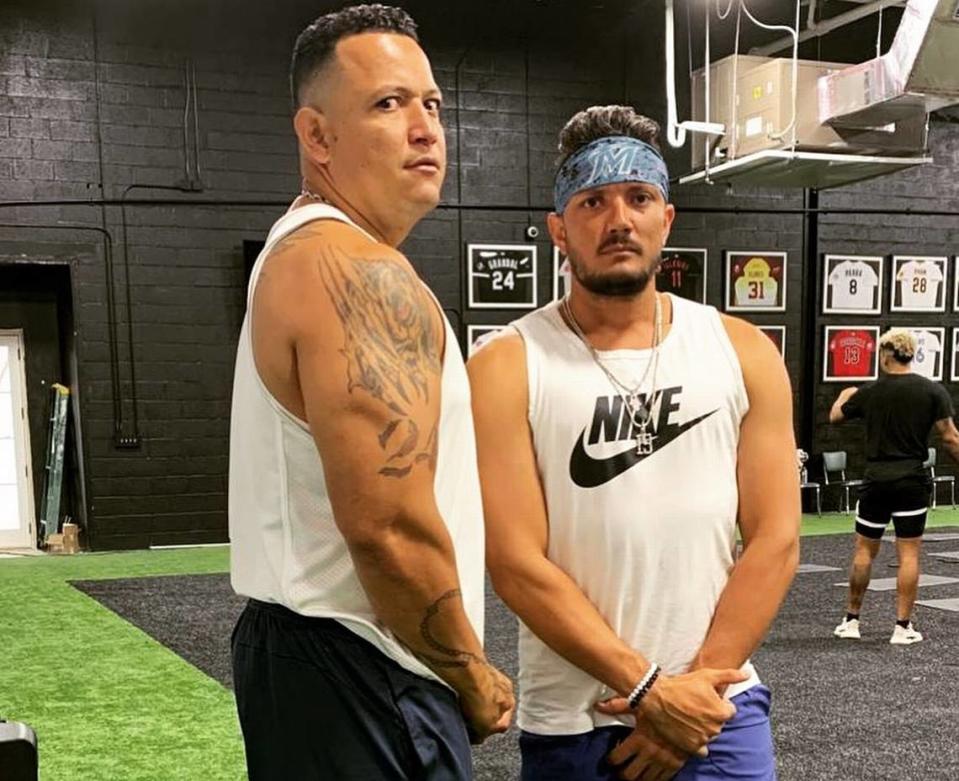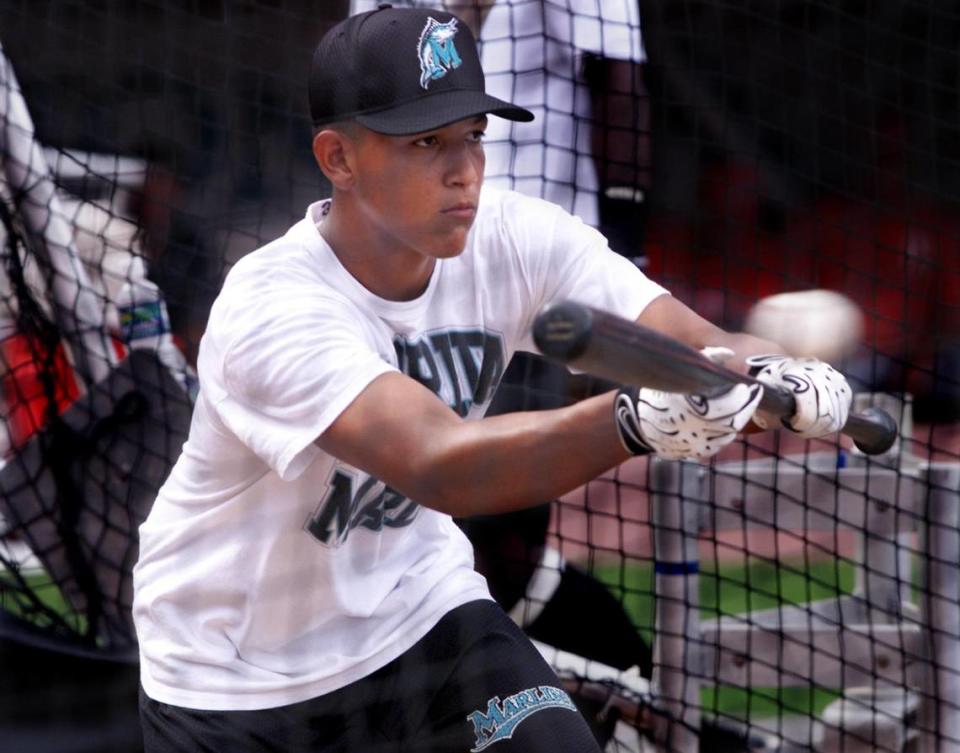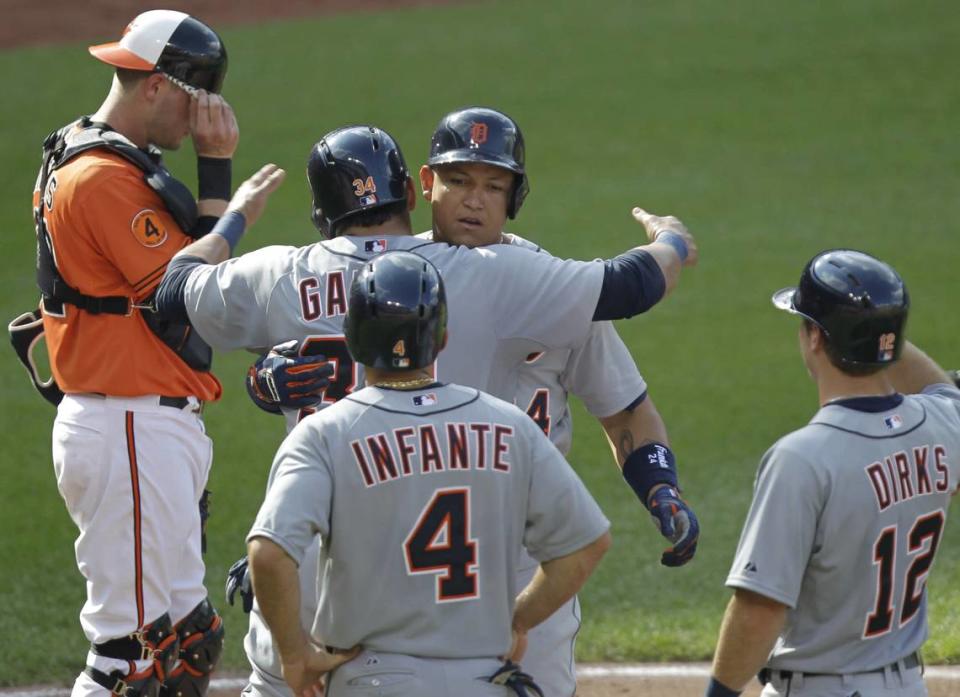As Miguel Cabrera reaches 3,000 hits, his impact is appreciated by Venezuelan Marlins
Miguel Rojas, like so many others of Venezuelan descent, has been keeping a close watch on the countdown.
Every hit, whether a bloop single or a home run, has gotten Miguel Cabrera — Rojas’ friend, his idol, his countryman — closer to history.
And on Saturday, with his single through the right side against the Colorado Rockies, Cabrera became the 33rd player — and first born in Venezuela — to log 3,000 hits in his MLB career, one that started as a highly touted prospect with the Marlins and has continued into his 20th season in the majors.
“All of us Venezuelans feel so proud of the way that Miguel Cabrera is reaching more and more goals,” Rojas said. “It’s becoming not just Miggy. It’s becoming the whole Venezuelan country represented by him. We all get excited. When he started reaching those goals and getting closer to that [milestone], every at-bat paralyzed the whole country. Everybody’s watching. He’s a big figure, not just in baseball, but outside the game as well because of all the things that he’s done in Venezuela.”
It’s a moment and a milestone more than two decades in the making for Cabrera.
And his impact on the game is still felt by some in the Marlins’ clubhouse and among many in the organization, even almost 15 years after he was traded to the Detroit Tigers.
The Marlins have six players with Venezuelan roots on their active roster — three position players in Rojas, first baseman Jesus Aguilar and outfielder Avisail Garcia as well as three pitchers in Pablo Lopez, Elieser Hernandez and Jesus Luzardo — and Cabrera’s journey is one they are invested in watching until the very end.
“Everybody’s paying attention to what he’s doing right now,” said Aguilar, who was born in Maracay like Cabrera. “I’ve been watching him. At the end of the day, it’s great for us, it’s great for the game and the Venezuelan guys.”

One Miggy’s appreciation for another
For Rojas, the connection was simple. He was tied to Cabrera by their home country and their first name.
“For me,” Rojas said, “he was always the guy. ‘I want to hit like Miggy. I want to be like Miggy.’ And coming in, with my name being Miguel too and people calling me Miggy here, it’s an honor.”
But with that honor comes a responsibility. Rojas joined the Marlins in 2015, eight years after Cabrera was traded.
“I feel like I have big, big shoes to fill when people call me Miggy,” Rojas said, “because I want to be as good as he is.”
Rojas, the Marlins’ de facto captain, knows those are lofty expectations for himself but he doesn’t let that deter him from dreaming big or learning from one of the best Venezuela has to offer. The two work out together in Hialeah during the offseason and have a friendship off the field.
And with each passing hit, Rojas remains in awe of what Cabrera is still able to accomplish on a baseball field.
“He’s in the back end of his career,” Rojas said, “but he’s still doing great things. We’re gonna be well represented by Miggy in the Hall of Fame and I know he’s going to be a first-ballot candidate and he’s gonna make it there, but we have to enjoy everything that he’s doing.”

First impressions proved right
Miguel Cabrera’s list of accolades is long — 2003 World Series winner, two-time American League MVP, 11-time All-Star, AL Triple Crown winner in 2012, seven-time Silver Slugger, four-time AL batting champion, the list keeps going.
It didn’t take long for Cabrera to show off his phenom potential after he signed with the Marlins as an international free agent in 1999, a deal that included a $1.8 million signing bonus — at that point the highest ever for a player from Venezuela.
You can start with the workout session he had at Pro Player Stadium in August 1999, where he gave local media their first in-person taste of what was to come in his career as he fielded ground balls and took batting practice.
“Look at that,” then-Marlins scouting director Al Avila, now the Tigers’ vice president of baseball operations, said at the time as he watched the workout unfold. “He’s showing off. He’s 16 years old, playing in front of all of these people. You got to have some [guts] to do that.”
Avila’s scouting report of Cabrera back in 1999: “He’s 6-2. He’s a big strong kid and he’s going to get bigger. He has a plus arm. He’s got good hands; he’s a good fielder, and he’s a good hitter with projected power. He’s got everything you want. The only thing he doesn’t have is blazing speed. He has tools, and a guy at 16 normally doesn’t have those tools.”
For Luis Dorante Sr., a native of Coro, Venezuela, Cabrera’s talent was undeniable. Dorante was Cabrera’s manager in 2002 when Cabrera played for the Jupiter Hammerheads, then the Marlins’ High A minor-league affiliate. Even with Cabrera viewed in high regard and expectations swarming him before he turned 20, Dorante never saw him waver or change the way he attacked the game.
“He wasn’t worried about hitting home runs,” Dorante said. “It was a gap-to-gap approach. Stay up the middle with the ball. It paid off. Look where he’s at now.
“I haven’t seen it in person, another hitter like him,” Dorante continued. “When you see that kind of hitter at 18, you say ‘Well, this kid is going to be a phenom. ... This is some gifted guy.”
Back then, back at that 1999 workout, how long did Cabrera think it would take for him to make his MLB debut after he signed?
“Four years,” Cabrera said.
He was close. It only took him three years and 10 months.
But at that point, 16-year-old Cabrera was just soaking in the moment, envisioning what would hopefully come his way in the not-so-distant future.
“Being around the big-league players,” Cabrera said then, “I was kind of in awe.”

‘There’s only one Miguel Cabrera’
Players, especially his fellow countrymen, now feel the same way when they’re around him.
Take Avisail Garcia as an example.
Garcia had just turned 12 years old a week before Cabrera made his MLB debut. Cabrera got his first hit on that June 20, 2003, day — an 11th-inning walk-off home run to lead the Marlins past the Tampa Bay Devil Rays.
Cabrera went on to hit .268 in his rookie season with 12 home runs, 21 doubles, 62 RBI and 39 runs scored over 87 regular-season games.
He then continued his success in the playoffs, getting hits in 11 of 15 postseason games he appeared as the Marlins won the 2003 World Series.
“A big fan of Miggy, of course,” Garcia said.
In time, Garcia got to see a portion of Cabrera’s dominant run in person as a teammate. Garcia made his MLB debut in 2012 with the Detroit Tigers, getting called up for the final month of the regular season ahead of Detroit’s run to the World Series. Garcia was traded to the Chicago White Sox in the middle of the 2013 season.

During their time as teammates, Garcia was given the nickname “Mini Miggy” because of his physical resemblance to Cabrera — both are 6-4 and bat from the right side in addition to being countrymates.
But Garcia is fine with the comparisons stopping there.
“There’s only one Miguel Cabrera,” he said.
“We feel proud about what he’s done for the game and for the passion of the game,” he continued. “He’s the best born player from Venezuela and I’m happy for him.”
Hit No. 3,000 was all but an inevitability — a matter of when, not if.
It came Saturday.
And one thing is certain: The celebration of Miguel Cabrera’s success isn’t going to stop now that the milestone is hit.
“I hope he stays healthy the whole year,” Aguilar said, “so he can do what he does best: Keep hitting.”
